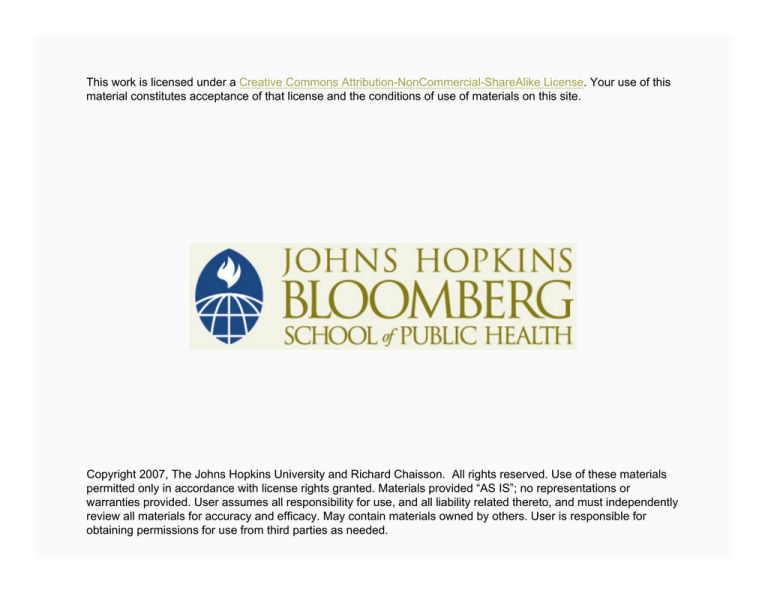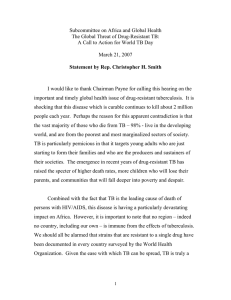
This work is licensed under a Creative Commons Attribution-NonCommercial-ShareAlike License. Your use of this
material constitutes acceptance of that license and the conditions of use of materials on this site.
Copyright 2007, The Johns Hopkins University and Richard Chaisson. All rights reserved. Use of these materials
permitted only in accordance with license rights granted. Materials provided “AS IS”; no representations or
warranties provided. User assumes all responsibility for use, and all liability related thereto, and must independently
review all materials for accuracy and efficacy. May contain materials owned by others. User is responsible for
obtaining permissions for use from third parties as needed.
TB Epidemiology
Richard E. Chaisson, MD
Johns Hopkins University
Center for Tuberculosis Research
Richard E. Chaisson, MD
Professor of medicine, epidemiology,
and international health
Director of the Johns Hopkins University
Center for Tuberculosis Research
Co-founded the Johns Hopkins HIV
Clinic cohort
Interests focus on tuberculosis and
HIV infection, including global epidemiology and control,
prevention, clinical trials, and public health interventions
Principal investigator of the Consortium to Respond
Effectively to the AIDS/TB Epidemic (CREATE)
3
Section A
General Epidemiology and Natural History
Statistics
“There are two kinds of statistics. The kind you look
up and the kind you make up.”
— Archie Goodwin in Rex Stout’s Nero Wolfe
mystery Death of a Doxy, 1966
5
Highlights of 2006 Global TB Report
About 9 million new cases in 2004
− Sixteen million prevalent cases
− Ninety-eight percent in developing countries
More than 10% increase since 1997
Increasing rates in Africa and Eastern Europe
− Decreasing elsewhere
1.9 million deaths
− Leading cause of death in people with HIV
Progress in case detection, but >50% still not diagnosed
and treated!
6
Growth of TB in Africa and Eastern Europe
7
Estimated Number of TB Cases by Country, 2004
8
Estimated Incidence of TB by Country, 2004
9
Twenty-Two High-Burden Countries
10
Reported TB Cases, United States, 1982–2003
11
TB Case Rates* by Age Group and Sex, United States, 2003
*Cases per 100,000
12
Cohort Analysis of Effect of Age on TB Incidence
Source: Comstock GW. Frost Revisited: The Modern Epidemiology of Tuberculosis: The Third Wade Hamptom Frost
Lecture. Am. J. Epidemiol..1975; 101: 363-382. By permission of Oxford University Press. All Rights Reserved.
13
TB Case Rates* by Race/Ethnicity
*Cases per 100,000
14
U.S.-Born vs. Foreign-Born
15
Length of U.S. Residence Prior to TB Diagnosis, U.S.
16
Epidemiology of TB Fundamentals
Reservoir of infection Æ humans (cattle)
− Virtually all transmission is person to person
Two-stage process
− Initial infection with M. tuberculosis
− Progression from infection to disease
17
Epidemiology of TB Fundamentals
Risks for initial infection
− Source case factors
− Environmental factors
− ? Recipient factors
Risks for disease once infected
− Inoculum size
− Cellular immunity
− Body habitus
− Genetics
18
Risk of Infection and Disease among Exposed Individuals
No infection
70%
Exposure
(close contact)
Infection
~30%
Risk factors
– Close contact, BR>HH>Casual
– Duration of contact
– Severity of disease, cough, cavities
19
Number of Droplets Produced by Different Activities
20
TB Infection in Children by Type of Contact
21
TB Infection among Inflight Personnel
22
Risk of Infection and Disease among Exposed Individuals
23
HIV and Risk of TB Disease among Infected Individuals
24
Diagnostic Standards for Tuberculosis
Latent TB
Tuberculin skin test
− PPD-S
− Cutpoints for positive
− Nonspecific
Interferon-gamma assays
Active TB
CXR
Sputum smear
− Sensitivity 50%
Sputum culture
Clinical criteria
25
Quantiferon for Latent and Active TB Diagnosis
Sensitivity
Cx+ TB pts
Specificity
BCG-vaccinated
new nurses
TST
Quantiferon
PPD
Quantiferon
Gold
65.7%
50/76 ≥5 mm
82.1%
92/112+
89.0%
105/118+
35.4%
40/113 <10 mm
56.0%
108/192-
98.1%
213/216-
Source: Mori et al. (2004, July 1). Am J Respir Crit Care Med, 170(1), 59–64.
26
ELISPOT and TST in School Contacts of Infectious TB
27
Response to ELISPOT or TST by BCG Vaccination Status
Response to ELISPOT or TST by BCG vaccination status
in a school TB outbreak
Vaccinated
(n = 467)
Unvaccinated
(n = 68)
ELISPOT
Positive
Negative
131 (28.1%)
336 (71.9%)
16 (23.5%)
52 (76.5%)
Heaf grade
4
3
2
1
0
52 (11.1%)
81 (17.6%)
110 (23.6%)
116 (24.8%)
108 (23.1%)
10 (14.7%)
2 (2.9%)
10 (14.7%)
13 (19.1%)
33 (48.5%)
p for vaccinated
vs.
unvaccinated
0.44
0.002*
*χ2 test for trend across all five Heaf grades
Source: Ewer et al. (2003, April 5). Lancet, 361(9364), 1168–1173.
28
Section B
Epidemiologic Basis for TB Control
Strategies for Control of Tuberculosis
Detection and treatment of cases
Treatment of latent infection
Vaccination
30
Definitions of Tuberculosis Control
Diagnosis of 70% of all cases, with cure rates of 85%
(WHO/IUATLD)
R0 <1
− Less than one secondary case for each new case
(Frost, 1937, Anderson and May, 1982)
The incidence of tuberculosis goes down
31
Control Strategies for TB
32
Use Dots More Widely
33
DOT vs. DOTS
Directly Observed Therapy
− Supervision of all doses of TB medication by a health
team member
Directly Observed Therapy, Short Course
− WHO policy for TB control, with programmatic
imperatives to strengthen TB control efforts
34
What Is DOTS?
Governmental commitment to TB control
System for registration and follow-up of TB cases
Reliable supply of TB drugs
Microbiologic confirmation of TB diagnosis
Supervision of at least the initial phase of TB therapy
35
TB Rates in U.S. Cities with High Incidence
36
Treatment Outcomes by WHO Region
37
DOTS Results in TB Incidence Decline
38
AFB Smears Performed by the TB Program, Peru
39
Full DOTS Implementation in Vietnam
40
What Can DOT(S) Do?
Increase treatment completion rates
Reduce the emergence of drug-resistant TB
Improve cost-effectiveness of TB control
In conjunction with other interventions, reduce TB
incidence
41
Section C
Challenges in TB Control
Challenges in the Control of Tuberculosis
HIV epidemic
MDR tuberculosis
Health system weaknesses and lack of political will
− Poor infrastructure and lack of support
− Weak organization of primary health services
− Private practitioners
− Prisons
43
Tuberculosis and HIV
44
Measured prevalence of HIV in TB patients (%)
Tuberculosis and HIV
Estimated prevalence of HIV in adults (%)
45
Uganda: Falling HIV Prevalence, Increasing TB Incidence
Rising TB incidence in setting of falling HIV prevalence in
Uganda
46
TB in Botswana: Pre- and Post-DOTS, HIV
47
Reported TB Cases, U.S., 1979–1999
48
Major Challenges in HIV-Related TB
Case detection
− High prevalence of active TB in community
X 3% of HIV+ pregnant women
X 8% of HIV VCT clients
− Negative smears more common
Treatment of TB and HIV
− Drug interactions
− Drug toxicity and adverse reactions
Prevention
− Use of preventive therapy
49
WHO/IAUTLD Survey of TB Drug Resistance, 1996–1999
Primary drug resistance—median 10.7%
− Primary MDR—median 1%
Acquired drug resistance—median 23%
− Acquired MDR—median 9.3%
MDR “hot spots” widespread
Source: Espinal. (2001). N Engl J Med, 344, 1294–1303.
50
Primary MDR TB, United States, 1993–2002
Note: Based on initial isolates from persons with no prior history of TB.
MDR TB defined as resistance to at least isoniazid and rifampin.
51
MDR-TB and XDR-TB in HIV+ Patients, South Africa
41% of hospitalized patients in rural KwaZulu-Natal had
MDR-TB
25% of these had XDR-TB
− Resistant to first- and second-line TB drugs
All HIV+
52 of 53 died
Median survival: 16 days
Source: Gandhi et al. (2006, August). International AIDS Conference, Toronto, Canada.
52
Global Approaches to MDR TB Control
Expansion and strengthening of DOTS
− Prevent creation of MDR cases through
mismanagement
− Assure access to drug supply
DOTS-Plus
− Second-line drugs for TB in setting of DOTS
− Green Light Committee of WHO
X Approves proposals for national DOTS+ programs
New drug development
− Global Alliance for TB Drug Development
53
BCG* for Prevention of TB
Live attenuated vaccine derived from M. bovis early
1900s by Calmette and Guérin
Most widely used vaccine in the world
Efficacy shown in clinical trials in 1930s–1950s
Recent trials show lack of benefit
Genetic evidence of attenuation of strain over years of
laboratory passage
New vaccines in development, but will need to be
compared with BCG
*Bacillus of Calmette and Guérin (BCG)
54
Meta-Analysis of BCG Effectiveness in 26 Studies
Outcome/design
Relative odds or risk
95% CI
TB prevention
Clinical trials
Case-control studies
0.49
0.50
0.34–0.70
0.39–0.64
Prevention of death
Clinical trials
0.29
0.16–0.53
Source: Colditz et al. (1994). JAMA, 271, 698–702.
55
Relationship to Lab Passage to BCG Efficacy
56
Strategies for Control of Tuberculosis: Limitations
Detection and treatment of cases
− Poor diagnostic capabilities
− Poor compliance with treatment
− Emergence of drug resistance
− HIV epidemic
Treatment of latent infection
− Resources for screening and treatment
Vaccination
− Current vaccine doesn’t prevent disease or
transmission
57
Imperatives for Controlling TB in the Coming Years
Expand DOTS
Increase case finding
Evaluate and treat contacts of cases
Treat high-risk patients with latent TB
Decrease HIV prevalence
Provide effective treatment for HIV
Develop effective HIV and TB vaccines
58


